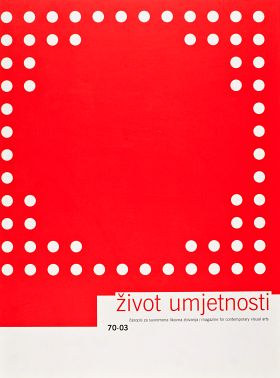Život umjetnosti 70 (2003.)

Cijena: 1,99 €
UREDNICA BROJA: Leonida Kovač
GLAVNA I ODGOVORNA UREDNICA: Sandra Križić Roban
UREDNIŠTVO: Branka Stipančić, Petar Prelog
AUTORI: Leonida Kovač, Berislav Valušek, Edit Andras, Phyllis Braff, Ana Maria Tavares Cavalcanti, Antje von Graevenitz, Alti Kuusamo, Mária Orišková, Bojana Pejić, Kimmo Sarje, Brandon Taylor, Marianne de Tolentino, Liviana Dan, Catherine Francblin, Nina Getashvili, Liam Kelly, Elaine A. King, Yacouba Konate, Matko Meštrović, Dag Solhjell, Katlin Timár, Tina Gharavi, Taava Koskinen, Miriam van Rijsingen, Agnieszka Taborska
OBLIKOVANJE: Igor Kuduz – Mario Aničić, pinhead_ured, Zagreb
–
From the 1960s onwards, the philosophy of art, or rather its critique, has – through deconstruction of the basic concepts on which the modernistic myth is based – been pointing to the existence of complex mechanisms and social technologies of production of meanings which can be ideologically mobilized with the aim of preserving the status quo to which art, just like all other areas of human activity, is not immune. It has become clear that what we call art is not only subject to the influences of ideology, but in fact functions as a constituent part of a specific ideology. The aim of the theme of this Congress was to determine possible extensions of the concept of art. The theme Strategies of power was divided into three sub-themes, each of which was the subject of one-day discussions. The sub-themes are as follows: I. THE LEGACY OF MODERNISM AND THE IMPERATIVE OF MODERNITY (…) II. INSTITUTIONAL FRAMEWORKS (…) III. SEXUALITY AND POWER.
Leonida Kovač (iz uvodnika)
SADRŽAJ
6–7
Leonida Kovač
Strategies of power
8
Berislav Valušek
Introduction
LEGACY OF MODERNISM AND THE IMPERATIVE OF MODERNITY
10–17
Edit Andras
Who’s afraid of a new paradigm? the old practice of art criticism of the east versus the new critical theory of the West
18–20
Phyllis Braff
Current directions
22–24
Ana Maria Tavares Cavalcanti
L’influence de la critique moderniste sur la construction de l’histoire de l’art au Brésil
26–27
Antje von Graevenitz
Postmodernism in the pictorial arts on the subversion of a subversive art
28–29
Alti Kuusamo
Dissociating functions of the sign: what to do with description in art criticism
30–33
Mária Orišková
New grand narratives in East-central European art history?
34–43
Bojana Pejić
Lady Rosa of Luxembourg, or, is the age of female allegory really bygone?
44–46
Kimmo Sarje
Modernism and the play of shadows
48–49
Brandon Taylor
Does montage have a future?
50–54
Marianne de Tolentino
Arte moderno del Caribe: una alianza sin contradiccion
INSTITUTIONAL FRAMEWORKS
56–57
Liviana Dan
When attitude becomes form
58–61
Catherine Francblin
Les années 90 en france: une nouvellle relation artistes/critiques
62–64
Nina Getashvili
The power of a curator, or the discreet charm of a murderer
66–69
Liam Kelly
Taking to the streets
70–75
Elaine A. King
Passivity & power – keys to change
76–79
Yacouba Konate
Les cadres institutionnelles des arts plastiques en Afrique
80–83
Matko Meštrović
To be a volunteer in arts – whom it may concern and what for?
84–89
Dag Solhjell
The defeat of the curatoriat / Odd Nerdrum – a case study of the aquisition and use of symbolic power
90–92
Katlin Timár
In and out of ideology: changing politics of interpretation
SEXUALITY AND POWER
94–103
Tina Gharavi
Veiled societies / hidden sexualities: investigating and documenting gender & public space in Tehran, Iran and Buffalo, NY
104–105
Taava Koskinen
Gendered images and brands. The social production of contemporary artists
106–110
Tomek Kitlinski, Pawel Leszkowicz
Iconographies of xenofobia
112–116
Miriam van Rijsingen
Insights and dividing lines: the medical-anatomical body in contemporary art
118–127
Agnieszka Taborska
A good muse needs no head – headless women in surrealist art
Cijena: 1,99 €